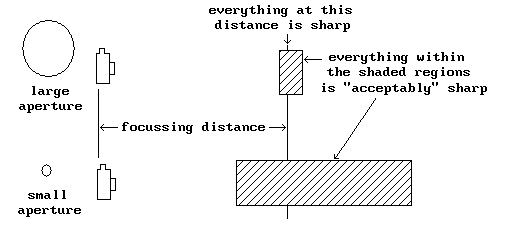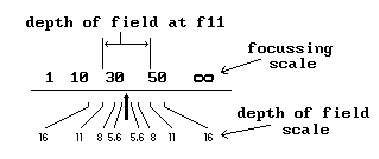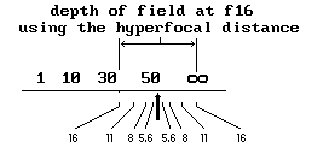Aperture and Depth of Field
While the main reason to set the aperture is to control the exposure, it does have another very useful effect - depth of field.

When you focus a lens you are making sure than everything at one particular distance is sharp. In theory only the thing you focus on is sharp. In practice there is a range of distances which are not quite in focus, but good enough. This distance between the nearest and furthest distances which are acceptably in focus, is called the depth of field.
The aperture determines how much either side of the focussing distance is acceptably in focus. A wide aperture, such as f4 will produce a smaller range than a small aperture such as f16.
Now, why would you want to do this? If you are taking a portrait, you want the subject to be the face, not the cluttered background. If you choose a small depth of field, the background will be out of focus. Now suppose that you are taking a photograph of a landscape. This time you want everything to be in focus from the furthest hills to the nearest grass and rocks. In this case you choose a large depth of field.
Other Things which Affect Depth of Field
Aperture is not the only thing which affects depth of field.
Wide angle lenses produce a much greater depth of field than telephoto lenses. So, use a wideangle lens for landscapes to make sure everything is sharp, and a telephoto lens for portraits to throw the background out of focus.
Anyone who takes a lot of closeups will tell you that the depth of field is less the closer you focus. By the time you try to fill the frame with something as small as a moth, the depth of field will be just a few millimetres.
The Depth of Field Scale
The depth of field scale allows you to see where the nearest and furthest limits are. You will find it either side of the index mark on the focussing scale. It consists of a series of marks labelled with f-numbers (8, 11, 16 etc.).

What you do is look at the marks labelled with the f-number you are going to use. If you are going to use f11, look at the marks labled f11.
The depth of field scale allows you to see where the nearest and furthest limits are. You will find it either side of the index mark on the focussing scale. It consists of a series of marks labelled with f-numbers (8, 11, 16 etc.)
What you do is look at the marks labelled with the f-number you are going to use. If you are going to use f11, look at the marks labled f11.
They indicate the distances on the focussing scale which represent the limits of the depth of field.
So, in the example shown in the diagram, the camera is focussed at just over 30 metres, and, at f11, the picture will be in focus from just under 30 metres to just under 50 metres.
Hyperfocal Distance

In landscape photographs you will usually want both the far distance and as much of the foreground as possible to be sharp. As you can see from the diagram, what you do is decide what f-number you are going to use, and set the focussing scale so that the infinity mark is against the furthest limit of the depth of field scale. This means that the depth of field just reaches the far distance, with as much foreground as possible sharp.
When you do this, the camera is said to be focussed at the hyperfocal distance. As usual, the longest words are reserved for the simplest ideas.
Using the Shutter to Show Motion
So, the aperture setting can be used to select depth of field. Can the shutter be used to do anything interesting?
Shutters are concerned with time, and time is associated with motion. The faster the shutter speed, the less time the subject has in which to move. If it is moving slowly, this probably doesn't matter. If, on the other hand, you are trying to photograph a motor race, then it is very important.
There are (as usual) at least two schools of thought about how to show motion. One school says that you use a fast shutter speed to freeze everything; the other says that this destroys all impression of motion and that what you really want is lots of blur.
The choice is yours.
The important thing to remember, if you decide you want a sharp picture, is that what affects the picture is how fast the subject is moving across the picture:
- a racing car travelling at 180mph towards you does not move across the frame very quickly, so you can get away with a slow shutter speed;
- someone jumping stops for a moment at the top of the jump as they change from going up to going down - again you can get away with a slow shutter.
If, however, you decide that you really must photograph something moving very quickly across the frame, select the fastest shutter speed that the available light will allow, and hope for the best!
Don't suppose that just because you don't photograph sport, that you don't have similar problems. A common problem for landscape photographers is water. Do you use a fast shutter to make it look like ice? or a slow shutter to blur the movement?
As with the racing car, the answer depends how fast the water is flowing and whether it is moving across the frame. As a rough guide, to really blur the water you will need at least a fifteenth of a second (and a tripod); to freeze a fast falling waterfall you would probably want at most a five thousandth!
Hand Holding
The commonest source of movement in photographs is nothing to do with the subject. It is the photographer failing to hold the camera steady during the exposure.
Whether you can hold the camera steady doesn't only depend on the the shutter. It also depends onthe focal length. A telephoto lens has the effect of magnifying the image. It also magnifies any camera movement.
Most people can hand hold a camera so long as the number on the shutter speed dial is larger than the focal length. So, you can handhold a 50mm lens at a 60th of a second, but a 135mm lens will need at least a 250th.
top of page